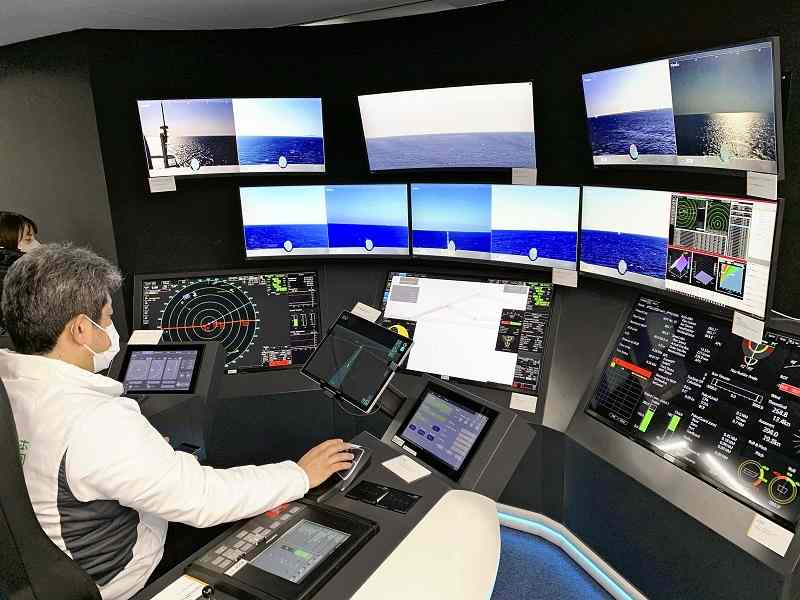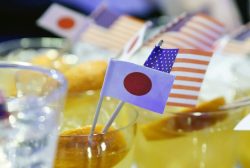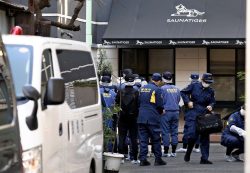
Officials look at monitors at an onshore support center to watch container ship Suzaku, operated by an automated navigation system.
14:40 JST, July 6, 2022
The shipping and shipbuilding industries are focusing their efforts on automated navigation systems, aiming to resolve such issues as the aging of seafarers and chronic staff shortages. An ongoing government-supported project is expected to be put into practical use by 2025.
Test trials were conducted for the project led by the Nippon Foundation between February and March this year. The 749-ton container ship Suzaku made a round trip between Tokyo Port and Tsumatsusaka Port in Mie Prefecture in four days, using an automated navigation system.
In automatic navigation systems, artificial intelligence analyzes the surrounding vessels and obstacles seen by onboard cameras, and then selects the best route for the vessel to navigate unmanned.
In the test trials, the captain and four other crew members were onboard in case an unexpected situation occurred, and the vessel was constantly monitored via satellite from the onshore support center in Chiba City. Should it be deemed necessary, the vessel could be controlled remotely from the center.
In the end, however, 97% of the 790-kilometer voyage was operated by the automated system.
Tokyo Bay, the departure point, and Ise Bay, where Tsumatsusaka Port is located, are considered to be among the world’s busiest waters.
“We were able to achieve results in difficult channels. This could help Japan to lead the world in the field of unmanned vessels,” said Yohei Sasakawa, chairman of the Nippon Foundation.
Total costs for the project stand at about ¥8.8 billion, and some 50 firms have participated. The goal is to achieve a certain level of automated navigation by 2025 and to realize completely unmanned navigation by 2040.
Tests for high-speed navigation, as well as departure and docking, have also been conducted on small tour boats and large car ferries.
Hopes for fewer accidents
In December 2020, the Land, Infrastructure, Transport and Tourism Ministry created safety guidelines for the development and design of vessels equipped with automated navigation systems.
The guidelines set out basic principles that “the division of roles between humans and systems should be clarified” and “the crew should be able to activate or deactivate the system at will.”
Apart from the Nippon Foundation project, test trials have been conducted in three fields: operation, departure and docking, and remote operation.
Behind the joint effort of public and private sectors is a sense of urgency in the industry arising from a labor shortage.
Among seafarers engaged in domestic marine transport of cargo and passengers, nearly half are 50 or older, and over 20% are 60 or older.
The total number of seafarers has remained flat at around 28,000 for the past 10 years. However, the job-to-applicants ratio for cargo ships has stood at a little over 2 to 1 since 2017, indicating a chronic labor shortage.
About 80% of cargo ship collisions occur because of human error in operation and watchkeeping. “Automation could contribute greatly to improving the work environment and reducing the number of accidents,” a transport ministry official said.
Chance to lead the world
The effort also could help the shipbuilding industry regain its footing.
Japan had the largest share of the global shipbuilding market until the 1990s. Now the market has been overtaken by China, which controls 40% of the market, and South Korea, which controls 31%. Japan’s share stands at 22%.
Being the global front-runner in the filed of automated navigation technology could lead to the revitalization of the shipbuilding industry.
“This could bring in new business opportunities, such as ocean transportation to remote islands,” said an official at Mitsui O.S.K. Lines, Ltd., a transport company taking part in the Nippon Foundation project.
Efforts have begun to create international rules on the practical application of this technology.
The International Maritime Organization has been holding discussions on such issues as liability in the event of an accident and qualifications for operating such ships remotely.
“Substantial progress has been made to put automated navigation technology into practical use,” said Keiji Habara, a visiting professor at Kobe University and an expert on maritime risk management. “For Japan to take the initiative in creating international standards for both technology and systems, across-the-board and continued efforts are necessary. This is a crucial time.”
"Business" POPULAR ARTICLE
-

Keidanren Chairman Yoshinobu Tsutsui Visits Kashiwazaki-Kariwa Nuclear Power Plant; Inspects New Emergency Safety System
-

Imports of Rare Earths from China Facing Delays, May Be Caused by Deterioration of Japan-China Relations
-

University of Tokyo Professor Discusses Japanese Economic Security in Interview Ahead of Forum
-

Tokyo Economic Security Forum to Hold Inaugural Meeting Amid Tense Global Environment
-

Japan Pulls out of Vietnam Nuclear Project, Complicating Hanoi’s Power Plans
JN ACCESS RANKING
-

Keidanren Chairman Yoshinobu Tsutsui Visits Kashiwazaki-Kariwa Nuclear Power Plant; Inspects New Emergency Safety System
-

Imports of Rare Earths from China Facing Delays, May Be Caused by Deterioration of Japan-China Relations
-

University of Tokyo Professor Discusses Japanese Economic Security in Interview Ahead of Forum
-

Tokyo Economic Security Forum to Hold Inaugural Meeting Amid Tense Global Environment
-

Japan Pulls out of Vietnam Nuclear Project, Complicating Hanoi’s Power Plans


























